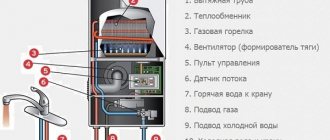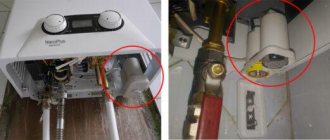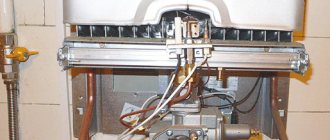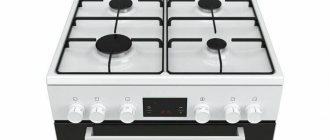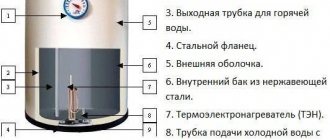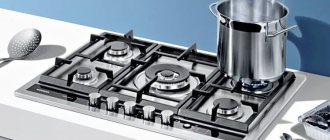Principle of operation
To understand the principle of operation of a geyser, you must first consider what security system it is equipped with. When the unit is in the off state, the control unit (16) does not receive electricity, since the circuit is broken in the microswitch (15). The switch plate is pressed by the pusher, and while this happens, it is in the off state.
The solenoid valve (19) is also closed and cuts off the gas supply from the inlet pipe, since it is not receiving power. But this is not the only place that shuts off the gas - it is also shut off using a spring valve, which is located in the gas module (35). The inoperative state of the valve is characterized by pressing the disc gasket against the seat, which ensures complete shutoff of the supply of the combustible mixture to the manifold.
The water section consists of a two-chamber module (36), colloquially called a “frog”, with an elastic rubber membrane. Using a special channel, the “frog” cameras can communicate. When the water supply is turned off, the pressure in the chambers is equalized and the membrane is in an equilibrium position.
The principle of operation of a gas water heater
Water is supplied to the heat exchanger through the bottom of the chamber. At the top there is a rod with a plate made of plastic, which is adjacent to the membrane. The rod comes out through a hole in the middle, towards the gas block. Opposite this rod, in the gas module, there is the same one, but connected to a spring valve, to which is attached a pusher coming from the switch.
What happens when the water starts
How does a gas water heater work if you dig up water? When you open a water tap at the point of consumption (water intake), the following happens.
- When a liquid flow passes through the “frog”, a vacuum is created in its chamber. The rubber membrane, under the influence of increased pressure, bends and pushes the plate out. The latter transmits the pushing movement to the rod. The water module rod pushes the opposite gas module rod (37).
- Next, the pusher, which is connected to the rod, no longer holds the switch plate, and it is released. In this case, the switch closes the circuit, and power begins to flow into the electronic control module from the battery section.
- The movement of the rod also forces the spring of the mechanical valve to depress, as a result of which the plate moves away from the seat, and the gas supply channel to the manifold becomes open.
- The solenoid valve, receiving power from the batteries, opens and does not interfere with the passage of gas through the spring valve towards the manifold.
- Meanwhile, the control unit generates and sends an electrical impulse to the spark plug (23) to create a spark discharge that can ignite the flame. When all components operate normally, the burner lights up.
The ignition process is controlled by an ionization sensor (24). If the burner does not ignite within 6-7 seconds, then, in order to avoid the accumulation of a high concentration of an explosive mixture, the electronic module, without receiving a pulse from the sensor, will shut off the gas supply. If there is combustion, the sensor will generate a pulse to turn off the spark plug. If, after the water heater starts operating, the flame goes out, then the impulse from the sensor will stop coming to the control module, after which it will immediately respond to this by shutting off the gas using the solenoid valve.
Performing all these functions in the Neva gas water heater is possible only if one condition is met: the circuit between the two sensors must not be broken, namely, between the outlet water temperature control sensor (29) and the draft sensor (32). These relays are connected in series and their contacts are closed when the sensors are operational. Therefore, in order for the control module to receive power, both sensors must complete the circuit.
If a weak draft is formed in the smoke exhaust unit, then the combustion products, due to the special design of the exhaust unit, cannot pass towards the central channel, and are directed to the side cavities. Since the temperature sensor is located on the left, it will “detect” a sudden rise in temperature, breaking the power supply circuit to the control module. This will stop the supply of the combustible mixture and turn off the burners.
By analogy, the relay, which is located on the pipe for removing heated water from the heat exchanger, is also activated. When the water heats up to 90°C, and this is considered a critical level, the power supply circuit of the electronic unit will be broken.
Work when the water is turned off
When the water supply is turned off, the following happens.
- The pressure in the “frog” chambers is balanced. Returning the rubber membrane to its place causes the plate connected to the pusher to move in the corresponding direction to the initial position.
- When the rod returns, the poppet valve is released, reliably shutting off the fuel supply.
- At the same time, the pusher begins to press the switch plate, as a result of which the circuit supplying the control module breaks.
- Since the solenoid valve does not receive electricity after the control unit is turned off, it also closes.
Thus, turning off the water triggers a chain of processes that automatically turn off the water heating device. For clarity, the photo below shows the main components of the unit (bottom view) that affect its operation (the numbering has been preserved and a new position has been added, number 40 is the microswitch pusher).
Main components of a gas water column
The information display (38) is also connected to the electronic control circuit of the water heater and the temperature sensor (39) on the outlet pipe using several wires. The display plays only an informational role and is not involved in the operation and configuration of the gas water heater.
The unit can also operate when the LCD display is turned off, for example, after removing the outer casing on which it is attached.
To summarize the above, we can say that the geyser is a fairly complex and reliable device to operate. Over the many years of existence of these units, their design has changed little, except that for more convenient control, electronic control and monitoring units began to be used in the devices.
How to choose a geyser
A gas instantaneous water heater is a powerful household appliance that has high performance and can provide hot water to several water points at the same time. The geyser operates on a fairly simple principle: cold water from the water supply passes through a powerful flow-type heat exchanger and is heated using a gas burner (it is ignited automatically) and immediately immediately flows to the water dispensing point - the tap.
Those who have ever used a water heater of this type can say with confidence that this is a truly effective and quite economical unit that quickly and efficiently solves the problem of hot water supply in a city apartment, country house or country house - if only there was gas. Basically, almost all models of flow-type gas water heaters operate on main (natural) gas, and only a few – on liquefied gas. The latter are popular among summer residents who do not have the opportunity to install main gas into the house. We will tell you how to choose a geyser based on the main parameters and be satisfied.
A instantaneous gas water heater is a fairly powerful unit, and when choosing, this point must first be taken into account. The more powerful the device, the more productive it is. If you plan to use it only for heating water in the kitchen or only for taking a shower, it will be enough to buy a gas water heater with a capacity of 17 to 20 kW. Such a device will produce about 11 liters of hot water per minute, which is quite enough for the above purposes. If you plan to use hot water supply in several water taps at the same time (for example, in the kitchen and bathroom), you will need a more efficient water heater with a power of 20-27 kW, capable of heating up to 15 liters of water per minute.
Another important parameter that will help you choose a gas water heater is the ability to adjust gas flow or, in other words, flame power. Adjustment can be manual (stepped and smooth) and automatic (flame modulation). Stepwise and smooth flame power adjustments are manually set by the user. The desired temperature of the heated water during operation of a geyser with manual adjustment of gas flow may differ from the one set by the user. By the way, experts do not recommend adjusting the temperature of the water leaving the tap by mixing cold water from the tap with heated water. Gas water heaters with automatic flame modulation will save you from unpleasant changes in water temperature, depending on various external factors. You can dilute too hot water coming out of the tap by simply opening the cold water tap slightly.
Some models of instantaneous gas water heaters allow you to regulate not only the flame power, but also the water flow. Such devices are especially relevant in homes with low water pressure in the water supply.
A very relevant parameter is the type of gas ignition. The times when gas in a geyser was ignited with matches are gone. Modern devices can be equipped with piezo ignition (a manual method of igniting a flame using a button), automatic ignition with a spark from ordinary batteries, or a spark from a small hydraulic turbine. It’s up to you to decide which gas water heater to choose, but we hope our short excursion into the world of gas water heating equipment will help you with this!
How does a geyser work?
Let's get acquainted with the principle of operation of a gas water heater in the form of a simple algorithm:
- when water flows through the water assembly, the membrane tenses and moves the rod connected to the gas valve upward;
- then the valve opens the gas supply to the main burner;
- the gas is ignited from an electrode or igniter, burns and heats the water that flows through the heat exchanger pipes;
- the heated water flow is supplied to the tap through the left pipe;
- gas combustion products are removed through a chimney or hood - there is a fundamental difference between open and closed type columns, which will be discussed in detail below.
The device of the water unit (reducer) of the gas water heater
The water unit of the gas column is located in front of the heat exchanger and regulates the operation of the column depending on the water flow. The water assembly can be made of brass, plastic or polyamide. The water unit is responsible for turning on the column and its functioning when water is supplied to the hot tap. The flow of water affects the parts of the water unit - the membrane and the disk, they in turn affect the rod, which regulates the operation of the valve of the gas unit. When water flows through the water unit, the gas supply is turned on. Accordingly, when the water is turned off, the gas supply is turned off.
The water unit consists of:
- Base and cover.
- Diaphragm with a disk attached to the rod.
- Flow regulator.
- Venturi nozzles.
- Flow regulator.
- Temperature selector.
- Water purification filter.
Gas water heater device
This water heating device has a fairly simple design and consists of the following elements:
- Draft sensor (installed on those models equipped with forced draft).
- Ionization sensor.
- Solenoid valve.
- Burner.
- Ignition electrode.
- Exhaust chimney.
- Battery compartment (not on all models).
- Heat exchanger.
- The combustion chamber.
- Igniter.
- Overheat sensor.
- Exhaust turbine (not installed on all models).
- Connection for connection to the gas main.
- Water node.
- Connection for connection to the water main.
- Connection for connecting to the DHW main.
- Control block.
- Frame.
Let us analyze the structure of each part of the gas water heater in detail.
Types of burners
Manufacturers produce several classes of columns, differing in the type of burner device and combustion chamber:
- Atmospheric speakers - there is an open combustion chamber. Air is drawn to the burner through natural circulation, directly from the room. The boiler is non-volatile. The main advantage: low cost.
- Turbocharged columns - the design contains a closed combustion chamber. Air is supplied by force, under pressure, pumped by a fan (turbine). Turbo columns have a flame modulation function. The flame temperature is maintained automatically, which allows it to adapt to the water pressure in the water supply. The main advantage of turbocharged water heaters: low gas consumption (15-20% less than atmospheric boilers), as well as the ability to operate at low water pressure. Turbo columns are connected to a coaxial or classic chimney.
How does a gas water heater work?
Since it is intended for heating, the essence of the work is simple: cold water is supplied through a pipe to the heat exchanger, under which there are burners, and here it is heated. Due to the need for oxygen for fire, the column is connected to the ventilation system. Therefore, the burners do not go out. The exhaust gas is removed through a special chimney combined with the equipment.
Water unit of a water heating apparatus
The design of the water unit of a geyser is almost the same, regardless of the model . The only difference is in the material:
- Plastic is very practical and durable.
- Brass is traditional for plumbing fixtures.
- Glass fiber reinforced polyamide.
The water flow, entering the assembly and acting on the reducer membrane, lifts the fungus into the gas block. The fungus, pressing on the valve, opens the gas to the burner. Thus, the task of the unit is to start when the hot water tap is opened.
Old models of gas boilers
The device of an old-style geyser involves a manual switching method .
Older models require matches to light the pilot light. The unit lights up if a special knob is turned. Its movement regulates the flow of blue fuel, which affects the water temperature. Modern models are safer, more practical, more convenient. New designs are equipped with either electronic ignition or a piezoelectric element.
Unlike the old-style geyser device, the electronic ignition system is capable of functioning fully automatically, without human intervention . This is reliable and durable equipment.
The system is turned on by supplying the charge necessary for a spark to appear, a pair of batteries. No buttons, no matches. The water tap opens and the system turns on. Batteries, by the way, last a long time, since the charge requires minimal energy.
Systems using piezo ignition are based on mechanical movement converted into an electrical discharge. It is easy to understand how this sample gas water heater works . Such models are activated by a button located on the front panel. When the equipment is turned on for the first time, a button is pressed on the panel to activate the piezoelectric element. The resulting spark ignites the igniter, and then when the tap is opened, the main burner turns on. Automatic mode is in effect.
What should you consider when choosing a water heater?
A household gas water heater is not a boiler for heating and it is difficult for the average user to choose it based on power. It is much clearer when it comes to the amount of water heated. This value is indicated in the technical data sheet of the product of any manufacturer and is expressed in liters per minute when heated to 25 °C.
For clarity, we present a table with data on water heaters of the Russian brand Neva, showing the dependence of performance on the thermal power of the unit:
Reference. Dispensers for DHW needs are inferior in efficiency to gas heating boilers by 3 to 5 percent. If the efficiency of an atmospheric heater is about 88%, then the efficiency of the same water heater is 84%. But it is impossible to feel this difference in practice.
When choosing a device for heating water, you first need to determine its performance. Next, we suggest following simple recommendations:
- If your budget is limited, and electricity is often cut off in your area of residence, then a simple non-volatile atmospheric model is just what you need. The ignition system is from a piezoelectric element or battery-powered; they last quite a long time (2-3 months with intensive use).
- In most apartments it is impossible to install atmospheric speakers due to the lack of chimney ducts, and the removal of combustion products into ventilation shafts is prohibited. No problem, buy a turbocharged water heater with a coaxial chimney that goes outside directly through the wall. Just determine the location of the pipe exit and coordinate it with your neighbors. Read more about connecting chimneys to gas water heaters in this article.
- In our conditions, when the water supply networks are worn out, it is better not to install devices with ignition from a hydrogenerator. The latter can quickly fail due to poor water quality and water hammer in pipelines. To protect the generator, you will need a water reducer, and this is an additional expense.
- Try to select modern modifications of devices where the igniter does not burn around the clock. It slowly but surely consumes gas, destroys the front wall of the heat exchanger and smokes onto the front panel.
Common faults
Like any gas-using equipment, the hot water column must be serviced and repaired by a specialist in this field. But there are a number of simple faults that the owner of a private house or apartment can fix on his own. The most common problems with instantaneous water heaters are:
- The igniter does not ignite.
- The wick burns, but after opening the tap the main burner does not turn on or ignites, but immediately goes out.
- There is insufficient water heating.
- Water begins to drip from the bottom of the case.
There can be many reasons for the occurrence of the listed symptoms, but we will indicate the most obvious ones, which the user can eliminate with his own hands.
The draft in the chimney should be checked regularly, as shown on the left. On the right is cleaning the heat exchanger from scale when the column does not heat the water.
It often happens that the igniter does not ignite due to a trivial reason - the batteries are discharged.
The cause of burner extinguishing may be:
- lack of draft in the chimney channel;
- faulty traction sensor or poor contact in its wiring;
- leaky membrane of the water unit;
- Inlet filter clogged (if equipped).
Low temperature of the leaving water, which happens after several years of operation, is usually associated with the appearance of scale in the heat exchanger and it will have to be washed. But drops of water from under the housing indicate a leak in some connection, safety valve or heat exchanger itself. The reason is the device overheating when the water is turned off.
Malfunction with overheating is inherent in atmospheric geysers. The mechanism is as follows: when the water is suddenly shut off and the burner is turned off, the heat exchanger remains hot, boiling occurs in it and steam is formed. If the situation is constantly repeated, the steam will eventually break out, breaking the weakest seal. Hence the recommendation: in such devices you must first turn off the gas and then turn off the water.
Recommendations for maintenance and repair
All elements of the column structure are subject to destruction due to various factors. Any gas equipment requires regular maintenance. If defects are identified during maintenance work, they must be eliminated as quickly as possible. Of course, some repair work should be entrusted to a professional, but some can be done independently.
Dismantling and adjusting the gearbox
You must first turn off the fuel and water supplies. Only after this can you begin to carry out preventive or repair work. To remove the gearbox, you need to perform several steps:
- Water is drained from the heat exchanger;
- using an adjustable wrench, the gas and water pipelines are disconnected from the column;
- If no mistakes were made at the previous stages, the gearbox can be easily dismantled.
Depending on the model of the unit, changes may be made to its design. To avoid problems when dismantling the water reducer, you must first disconnect all pipes and parts that make the work difficult. The housing should be easy to remove; no physical effort is required.
To adjust the gearbox, you must use special bolts located on the back side of the unit. Most often, the unit is already prepared for operation at the factory and does not require additional configuration. It is not advisable to adjust the unit unless absolutely necessary.
Cleaning the water unit
This event must be held at least once every 12 calendar months. When unscrewing the fastening bolts located on the unit cover, you must be careful not to damage the folds. When the cover is removed, it is necessary not only to clean the internal space of the gearbox, but also to perform the following procedures:
- All solid residues from the bottom of the part must be removed, and the coarse water filter must also be rinsed.
- It is advisable to lubricate the rod with grease or castor oil.
- If you suspect that the gasket has lost its former elasticity, it also needs to be lubricated.
With regular maintenance of the unit, its service life can be significantly extended. Most often, the rod seal and membrane fail. The first element must be replaced once every 3 years, and the second - after the appearance of ruptures or microcracks. In addition, during intensive work the spring for returning the rod to its original position may break.
Having carefully studied the design and principle of operation of the gas water heater, you can carry out all preventive measures yourself. If you don’t have confidence in your own abilities, then you should turn to professionals for help. When working with the unit, you must strictly follow the instructions.
